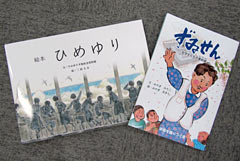Picture books about Himeyuri and Zuisen students published

Himeyuri Picture Book (left) and Zuisen - Female students at the Frontline were published on June 23, when the prefecture marked the 66th anniversary of the end of the Battle of Okinawa.
July 20, 2011 Eriko Tamaki of Ryukyu Shimpo
Two picture books have been published that tell the story of female high school students who joined nursing units in the Imperial Japanese Army during the Battle of Okinawa. They are the Himeyuri Picture Book (Himeyuri Alumnae Incorporated Foundation) and Zuisen – Female students at the Frontline (Okinawa Retired School Personnel Association Women’s Group).
A spokesperson for the project said, “We hope that the picture books will help promote discussion of the Battle of Okinawa within people’s homes.”
While the number of people who experienced the Battle of Okinawa is decreasing, the publishers hope that those who did not experience the battle could use these picture books to educate children about the war.
The power of a picture book
Although the Himeyuri Picture Book was sold only in the Himeyuri Peace Museum, it sold 300 copies on its first day.
What is different from in the past is that the book has stimulated a great deal of reaction from within the prefecture. Many teachers and parents praise the book, saying, “We would like to read it to our children and pupils.”
Thirty-four year-old Akiko Nakada, who works for the museum, said, “To be honest, I did not expect that there would be such a huge reaction. It makes me realize that people want things that are easily understandable.”
Since it opened in 1989, the Himeyuri Peace Museum has continued to emphasize the cruelty of wartime education that encouraged students to sacrifice themselves on battlefields, and also the preciousness of peace.
In 2004 the museum changed its displays so they do not need to be explained by those who have experienced the Battle of Okinawa, but it was still difficult for children to understand battlefield terminology such as “unassisted patients” or “Army Hospital.”
Eighty-three year-old Yoshiko Shimabukuro, the director of the museum, hopes to see benefits from the picture book, saying, “The book depicts the Battle of Okinawa in simple terms, making children read it again and again. People always remember books they read during their childhood.”
The staff of the museum considered pictures drawn by the artist and painter, Keisuke Mita for the Himeyuri Picture Book.
Fifty-one year-old Chokei Futenma, the head of curatorial office of the museum emphasized that during the book’s production process people who have never experienced wars inherited the memories of the Battle of Okinawa from those who have experienced it, saying “People from different backgrounds worked together and sifted through the relevant historical facts.”
How to convey the cruelty of the war
When a former female high school student who worked for the Imperial Japanese Army during the Battle of Okinawa talked to a group of elementary school students in the prefecture, she was faced with questions from the pupils such as, “How many people can start a war?” “When do people who get shot, get back up again?”
Survivor of the Zuisen Students, 85 year-old Michiko Miyagi, was shocked at this episode, saying, “Wars exist only on television for these children. They cannot imagine that the Battle of Okinawa actually happened in the past.”
Based on a collection of notes written by Miyagi and published in 2002, Okinawa Retired School Personnel Association Women’s Group created the picture book, Zuisen.
Seventy-one year-old Noriko Noguni, the director of the group, said, “We selected the scenes it depicts based on aspects of the cruelty of war, trying to make children actually understand the experiences in the Battle of Okinawa. For example, things like the pain for students when their friends were killed and seeing their schools gradually becoming militarized. These days, there are even children whose grandparents did not experience the war. We would like adults to read the picture book to their children and hope that both generations deepen their understanding of the war.”
(English Translation by T&CT, Mark Ealey)
Previous Article:Two endangered species flower inconspicuously up in the northern mountain area
Next Article:Okinawa Prefectural Assembly and Tainan City Council cooperate to promote Agricultural exchange
[Similar Articles]
- Himeyuri students publish new book telling the invisible wounds of the war
- Himeyuri Peace Museum attracts visitors with Takako Miyahira video
- Descendants of the Himeyuri Peace Corps visit the battlefield where the student nurses were mobilized for the 30-year anniversary of the Himeyuri Peace Museum
- Himeyuri Peace Museum marks its 25th anniversary
- After telling their story for 30 years, the Himeyuri Student Corps storytellers, now in their 90’s, to pass the baton to the post-war generation
 Webcam(Kokusai Street)
Webcam(Kokusai Street)


